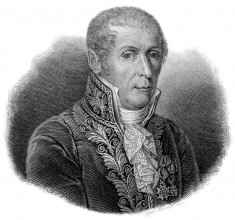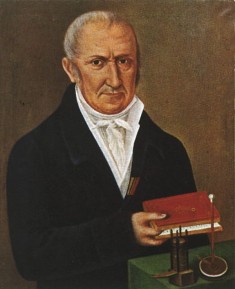| Alessandro Volta | |
|---|---|
 |
|
| Physicist | |
| Specialty | Electric cell, battery, methane, volt |
| Born | Feb. 18, 1745 Como, Duchy of Milan |
| Died | Mar. 5, 1827 (at age 82) Como, Lombardy-Venetia |
| Nationality | Italian |
Alessandro Volta is among the most popular Italian physicists. He first gained fame in 1775 with a charge-generating machine he invented while teaching physics in Como. Volta was appointed to Pavia University in 1779, where he continued with his work and invented a number of gadgets.
Early Life
Alessandro Volta was born in 1745 to a wealthy family and a strict Christian home. He attended a Jesuit school as well as a local seminary. Volta was dearly loved by his teachers who thought he had all the qualities to become a Jesuit priest. He wanted to study electricity which was in its early stages at the time.
Volta pictured that there was a net neutral condition in the body in which electrical attractions are balanced. This effect could be changed by an external source which later transforms the relative configuration of particles. He believed that in that electrically unstable condition, the body gets charged electrically.
Volta dropped his formal education and did not continue to study at a university. However, by the age of 18 he was corresponding with prominent scientists of the time and conducting experiments in the lab owned by a family friend. In 1769, he wrote a treatise in which he demonstrated a theory of electric phenomenon.
Volta’s Early Work
In 1774, Volta was appointed to be the professor of physics at the Royal School in Como. While there, he invented electrophorus, a gadget that produced static electricity. For years at the school, Volta applied himself to chemistry, researching atmospheric electricity, and doing experiments like ignition of gases by electric sparks in a closed vessel. In 1779, he became a professor of physics at the Pavia University, a position he occupied for 25 years.
Greatest Achievements
 Volta’s early inventions had already made him a popular scientist, but his greatest contribution to the field of science was the Voltaic Pile, which he built as part of a scientific disagreement with a scientist known as Luigi Galvani. In 1800, he came up with Voltaic Pile. The device was made of alternating disks of copper and zinc, with pieces of cardboard that was drenched in a saline solution. Attaching the wire to the ends produced a continuous current of low intensity. The Voltaic Pile was the very first direct current battery.
Volta’s early inventions had already made him a popular scientist, but his greatest contribution to the field of science was the Voltaic Pile, which he built as part of a scientific disagreement with a scientist known as Luigi Galvani. In 1800, he came up with Voltaic Pile. The device was made of alternating disks of copper and zinc, with pieces of cardboard that was drenched in a saline solution. Attaching the wire to the ends produced a continuous current of low intensity. The Voltaic Pile was the very first direct current battery.
His discovery put to an end Luigi Galvani’s theory of animal electricity. In fact, it was Volta’s disagreement with Luigi Galvani’s theory of galvanic responses that led him to invent the Voltaic Pile to prove that electricity did not come from the animal tissue but from contact of various metals, brass and iron, in moist surroundings.
Ironically, they were both right. His invention gave rise to electromagnetism, electrochemistry, and contemporary electricity applications. Galvani’s invention developed into electrophysiology as well as modern biology.
Volta’s Impact
The ability to produce electric currents changed the field of science and technology. As a physicist and inventor of instruments, he enjoyed unparalleled success, but today one must not forget his notable theoretical contributions as well which, although going against the Newtonian theory, were to prove helpful for the development of experimental sciences of the 18th century. Volta maintained that a contact of metals was enough to produce electrical difference of the pile’s end plates.
Awards and Honors
In honor of his invention in the field of science, Volta was made a Count by Napoleon Bonaparte in 1810. A museum in his hometown, the Voltian Temple, was named after him and showcases some of the instruments he utilized to conduct experiments. A few meters from Lake Como is the Villa Olmo, which houses Voltian Foundation, a non-governmental organization that sponsors scientific activities.
Volt is the unit of electromotive force, or dissimilarity of potential which inflicts a current of a single ampere to travel via a resistance of a single ohm. Photovoltaic are systems that transform light into electricity. The word “photo” is the stem from Greek “phos,” meaning “light.” The term “volt” is named for Alessandro Volta.
Volta’s Death
While his invention made him popular across Europe, Volta preferred a quiet life, and later gave up much of his research. He spent his last moments living in a country home in the town of Como, where he died in 1827, at the age of 82.